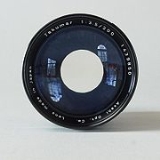
Takumar
Encyclopedia
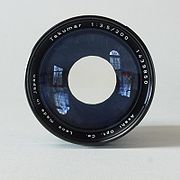
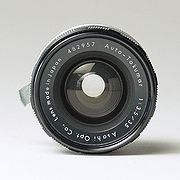
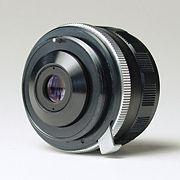

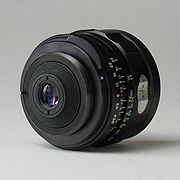
Pentax
Pentax is a brand name used by Hoya Corporation for its medical-related products & services and Pentax Ricoh Imaging Company for cameras, sport optics , etc. Hoya purchased and merged with the Japanese optics company on March 31, 2008. Hoya's Pentax imaging business was sold to Ricoh Company, Ltd...
gave to its lenses
Photographic lens
A camera lens is an optical lens or assembly of lenses used in conjunction with a camera body and mechanism to make images of objects either on photographic film or on other media capable of storing an image chemically or electronically.While in principle a simple convex lens will suffice, in...
, notably but not exclusively those for its own SLR
Single-lens reflex camera
A single-lens reflex camera is a camera that typically uses a semi-automatic moving mirror system that permits the photographer to see exactly what will be captured by the film or digital imaging system, as opposed to pre-SLR cameras where the view through the viewfinder could be significantly...
cameras. Named after the Japanese-American portrait painter, , whose brother Kumao Kajiware founded Asahi Optical, the name adorned its lenses until 1975, when Asahi switched from the M42 screw mount
M42 lens mount
The M42 lens mount is a screw thread mounting standard for attaching lenses to 35 mm cameras, primarily single-lens reflex models. It is more accurately known as the M42 × 1 mm standard, which means that it is a metric screw thread of 42 mm diameter and 1 mm thread pitch...
to the bayonet K-mount
Pentax K mount
The Pentax K mount, sometimes referred to as the "PK mount", is a lens mount standard for mounting interchangeable photographic lenses to 35 mm single-lens reflex cameras. It was created by Pentax in 1975, and has been used by all Pentax 35 mm and digital SLRs since...
. K-mount lenses were simply named "SMC Pentax".
The Takumar designation was used on lenses designed for Asahi's 35mm cameras, 6×7 cameras, and for other purposes too.
- Takumar lenses were made in M37 screwmount for the original Asahiflex cameras and continued into the M42 period.
- Auto-Takumar lenses were a type of preset lens. The user selected an aperture then engaged a lever to energise the stopping-down mechanism. The camera would then trip this mechanism when the shutter was fired.
- Super-Takumar lenses featured an early form of lens coating (to prevent flare) and a more sophisticated stopping-down mechanism. There was a switch on the lens to select "Auto" or "Manual" modes. In manual mode, the lens would always be in the selected aperture. In Auto mode, the lens would remain wide open (at maximum aperture) until a pin on the rear of the lens was pushed in. This pin would be automatically pushed in by the camera when the shutter was tripped.
- Super-Multi-Coated (later SMC) Takumar. These lenses introduced Asahi's lens multi-coating process. They also introduced a lug on the rear of the lens which moved with the aperture selected. When used with a camera body which could read the lug, this enabled the use of open-aperture metering. Examples of such cameras are Asahi's Spotmatic F and the ES/ESII.
The Takumar series of lenses has a very good reputation among users, with very few "dogs" anywhere in the line-up. This could be due to many factors:
- Cameras were expected to be made of metal, not plastic, and so the lenses were too.
- Zooms only became available towards the end of the Takumar period, and almost all Takumars were primes. Zoom lenses are inherently more difficult to design than prime lenses, and embody more compromises.
- Black-and-white film was poorer quality than now and therefore photographers used slower filmFilm speedFilm speed is the measure of a photographic film's sensitivity to light, determined by sensitometry and measured on various numerical scales, the most recent being the ISO system....
than would be common today; the only color film then available would now be regarded as slow. Therefore lenses had to be fast (to let in more light). A common lens for an SLR in the 1960s and 1970s was a 50 mm f/1.4 lens, which lets in about six to sixteen times as much light as typical f/3.5-5.6 zoom lenses.
Pentax resurrected the Takumar name in the 1980s and 1990s for a budget line of zoom and prime lenses that lacked the Pentax "Super Multi-Coating" anti-reflective coating
Anti-reflective coating
An antireflective or anti-reflection coating is a type of optical coating applied to the surface of lenses and other optical devices to reduce reflection. This improves the efficiency of the system since less light is lost. In complex systems such as a telescope, the reduction in reflections also...
, an optical treatment that reduces lens flare. These lenses are marked "Takumar (Bayonet)" to distinguish them from the older screw-mount Takumar lenses.
Non-Asahi cameras with Asahi lenses branded Takumar include the Suzuki Press Van and two versions of the Takane Mine Six.

